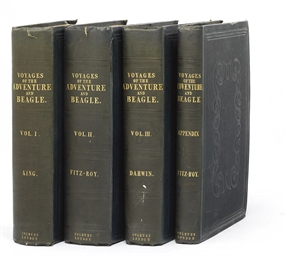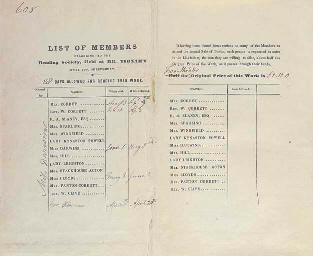CHARLES ROBERT DARWIN (1809-1882, EDITOR) The Zoology of the Voyage of H.M.S. Beagle, under the Command of Captain Robert FitzRoy R.N., during the Years 1832 to 1836 [Part III, Birds by John Gould (1804-1881), only]. London: [1838]-1841. 4° (304 x 238mm). 50 unsigned hand-coloured lithographic plates by Elizabeth Gould after John Gould (Plates 38-39 spotted, a few other plates with marginal spotting, several plate numbers cropped, occasional soiling of margins.) Contemporary brown morocco gilt, gilt edges (rebacked, corners restored, some chipping). Provenance : Quentin Keynes (1921-2003, gift to his doctor). THE KEY PART OF DARWIN'S ZOOLOGY , with contributions by Darwin, T.C. Eyton and G.R. Gray noted on the half-title and in the Advertisement. Although Gould departed for Australia on 16 May 1838 leaving an incomplete manuscript behind him, 'the daring concept of transmutation' began to emerge in Darwin's mind as a direct result of his findings. Superintendent of the ornithological department at the recently formed Zoological Society at the time Darwin sought his help, Gould classified and exhibited the majority of his birds at Zoological Society meetings during January and February 1837. At first Darwin was 'perplexed by Gould's announcement that the Galapagos finches constituted an entirely new group strictly confined to the Galapagos islands. Each bird represented a different species. All were unknown to zoological science'. When Darwin finally met Gould in March, he was informed that 'the various species also seemed mutually exclusive of each other from island to island'. Tantalisingly, Gould could not be sure because of Darwin's own inadequate labelling of the finch specimens. Then, at a talk given to the Zoological Society on 14 March 1837, Darwin heard the rare 'Avestruz Petise' described, not simply as a smaller geographical variety of the common rhea, but as a separate species which Gould named Rhea darwinii , 'cheerfully disregarding the name given by Alcide d'Orbigny, who also searched for it in Patagonia'. These unexpected findings led Darwin to the crucial realisation that geographical and chronological variation were parts of the same puzzle, and that 'Lyell's general principles linking past with present could be applied to the biological world as much as to the geological' (see Janet Browne, Charles Darwin: Voyaging , pp. 359-61). Anker 173; Freeman 9; Nissen IVB 384; Norman 586; Wood p. 310; Zimmer p. 157.
CHARLES ROBERT DARWIN (1809-1882, EDITOR) The Zoology of the Voyage of H.M.S. Beagle, under the Command of Captain Robert FitzRoy R.N., during the Years 1832 to 1836 [Part III, Birds by John Gould (1804-1881), only]. London: [1838]-1841. 4° (304 x 238mm). 50 unsigned hand-coloured lithographic plates by Elizabeth Gould after John Gould (Plates 38-39 spotted, a few other plates with marginal spotting, several plate numbers cropped, occasional soiling of margins.) Contemporary brown morocco gilt, gilt edges (rebacked, corners restored, some chipping). Provenance : Quentin Keynes (1921-2003, gift to his doctor). THE KEY PART OF DARWIN'S ZOOLOGY , with contributions by Darwin, T.C. Eyton and G.R. Gray noted on the half-title and in the Advertisement. Although Gould departed for Australia on 16 May 1838 leaving an incomplete manuscript behind him, 'the daring concept of transmutation' began to emerge in Darwin's mind as a direct result of his findings. Superintendent of the ornithological department at the recently formed Zoological Society at the time Darwin sought his help, Gould classified and exhibited the majority of his birds at Zoological Society meetings during January and February 1837. At first Darwin was 'perplexed by Gould's announcement that the Galapagos finches constituted an entirely new group strictly confined to the Galapagos islands. Each bird represented a different species. All were unknown to zoological science'. When Darwin finally met Gould in March, he was informed that 'the various species also seemed mutually exclusive of each other from island to island'. Tantalisingly, Gould could not be sure because of Darwin's own inadequate labelling of the finch specimens. Then, at a talk given to the Zoological Society on 14 March 1837, Darwin heard the rare 'Avestruz Petise' described, not simply as a smaller geographical variety of the common rhea, but as a separate species which Gould named Rhea darwinii , 'cheerfully disregarding the name given by Alcide d'Orbigny, who also searched for it in Patagonia'. These unexpected findings led Darwin to the crucial realisation that geographical and chronological variation were parts of the same puzzle, and that 'Lyell's general principles linking past with present could be applied to the biological world as much as to the geological' (see Janet Browne, Charles Darwin: Voyaging , pp. 359-61). Anker 173; Freeman 9; Nissen IVB 384; Norman 586; Wood p. 310; Zimmer p. 157.
.jpg)
.jpg)




.jpg)


.jpg)


.jpg)


Testen Sie LotSearch und seine Premium-Features 7 Tage - ohne Kosten!
Lassen Sie sich automatisch über neue Objekte in kommenden Auktionen benachrichtigen.
Suchauftrag anlegen